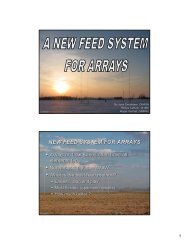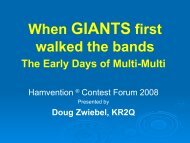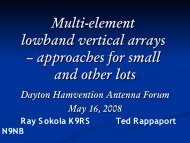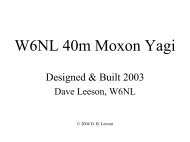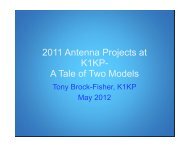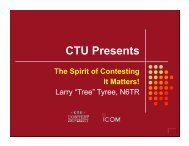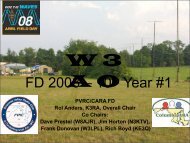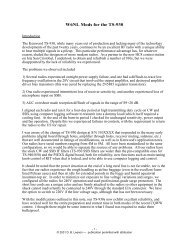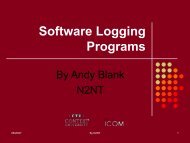TS-950 - Kkn.net
TS-950 - Kkn.net
TS-950 - Kkn.net
- No tags were found...
You also want an ePaper? Increase the reach of your titles
YUMPU automatically turns print PDFs into web optimized ePapers that Google loves.
KENWOOD <strong>TS</strong>-<strong>950</strong>S & <strong>TS</strong>-<strong>950</strong>SD RF GAIN MODThis mod is courtesy of KenwoodThe Kenwood <strong>TS</strong>-<strong>950</strong>S and <strong>TS</strong>-<strong>950</strong>SD HF transceivers are fine radios. However, many, if not all,of them were produced with a design flaw which allows the RG GAIN control to cease function inthe presence of a strong signal IF the AGC has been turned OFF.One common scenario goes something like this:1) Tuning around any band, in CW mode, with the AGC turned OFF, and using the RF GAIN tocontrol received audio level.2) RF Gain is set to allow moderately strong signals (c. S-9) to be received without excessiveaudio output (comfortable listening level).3) Tune through a strong (S-9 +10dB or more) signal. The receiver loses all control of the RFGAIN. The control becomes virtually useless you either tune off the strong signal or thesignal stops, at which point the RG GAIN control again becomes usable. Immediatelyswitching the AGC back ON, will also allow you to regain control of the RF GAIN, but if youagain return to AGC OFF, and the signal is still present, control is again lost.Although I have not tried it, I am told this problem can also occur in other receive modes as well.The following document is a re-typed version of the Kenwood Mod. Any typos have been allowedto remain in the narrative of the document. The schematic has been re-drawn in order to allow youto follow the mod more easily, not because the original drawing was in error, but because it wassomewhat difficult to follow the black & white line drawing.I have also included several photos of the Signal Unit PC board to assist you in locating theportion of the PC board which will require your attention.Note that you will be dealing with SMT-type devices which will require a significantly higher degreeof care when working with them then would be required if non-SMT devices were used. This isresult of progress(???) in manufacturing. You WILL have to use a soldering iron with a very smalltip, and you may have to use a magnifying lens to assist you in locating and removing the SMTdevices, not to mention installing the two jumpers required by the mod. Fortunately, NO additionalcomponents are required... only a couple lengths of #24 to #30 insulated wire (for the jumpers).Good luck - Tom Hammond NØSS nØss@arrl.<strong>net</strong> 28 Nov 2001
MODELSUBJECTCONTEN<strong>TS</strong><strong>TS</strong>-<strong>950</strong>S & <strong>TS</strong>-<strong>950</strong>SDNo RF Gain at AGC OFF and large input.REFERENCEPhenomena: 1) AGC is turned OFF. The RF GAIN is set maximum in thecounterclockwise direction.2) SSG is connected to the ANY pin. The SSG input is about 10dBµ.A signal is received on the SSB mode, and it is made sure that theS-meter's pointer swings (about S-3).3) The RF GAIN control is turned counterclockwise to set the Smeter's swing to S-9.4) The SSG input is changed from 10dBµ to 40dBµ. Then, the Smeter reading zero, and the RF GAIN becomes disabled.Cause:Insufficient study on switching transistors Q 30 and Q 40 (thesetransistors operate at AGC OFF) of AGC amplifier Q 10 in the signalunit.Countermeasure:The circuit of the AGC amplifier Q 10 is the signal unit (X57-3380-00) ismodified.a) Chip resistor R 135, it removed.b) Chip resistor R 136, is removed.c) Digital transistor Q 40, DTC124EK, is removed.d) Chip diode D25, RKZJ3.6B, is changed to chip jumper W8,( R92-0679-05 ).e) Short jumper W9, R92-1061-05, is added.
MODELSUBJECTCONTEN<strong>TS</strong><strong>TS</strong>-<strong>950</strong>S & <strong>TS</strong>-<strong>950</strong>SDNo RF Gain at AGC OFF and large input.REFERENCE
SIGNAL UNIT PC BOARD (X57-3380-00), BOTTOM OF <strong>TS</strong>-<strong>950</strong>SDBEFORE MODAFTER MOD




